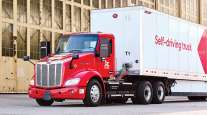Senior Reporter
Daimler Posts Q2 Net Loss, Lower Revenue as Pandemic Slashes Demand

[Stay on top of transportation news: Get TTNews in your inbox.]
The Daimler Group reported a net loss and lower revenue in the second quarter as demand for its trucks, vans, buses and cars fell amid the global novel coronavirus pandemic.
For the period ended June 30, Daimler (reporting in euros) had the equivalent of a net loss of $2.2 billion, or $2.17 per diluted share, compared with a net loss of $1.4 billion, or $1.44, a year earlier.
Revenue fell to $34.8 billion compared with $49.3 billion in the 2019 period. Total unit sales dropped 34% to 541,833 compared with 841,666 a year earlier.
We have released our business figures for the second quarter of 2020. #Daimler $DDAIF — Daimler AG (@Daimler) July 23, 2020
The Stuttgart, Germany-based company is one of the biggest producers of premium cars and the world’s largest manufacturer of commercial vehicles.
Overall truck production in Q2 dropped 60% to 50,887 units compared with 127,224 in the 2019 period. Production of cars fell 40%, vans fell 38% and buses fell 61%.
“We certainly have had to endure a complex quarter, three months that have been dominated by the COVID-19 pandemic,” said Daimler Chairman Ola Källenius during an earnings conference call. “We recorded a net loss in this quarter, but our results in the second quarter were partially above market expectations. In particular on the free cash flow. In general I think it is fair to say that our management of the challenges from COVID-19 is working, and at the same time we continue to make progress on our long-term strategic course and our efforts to lower the break-even of the company.”
Find all Q2 business results and performance figures in this video #Daimler $DDAIF — Daimler AG (@Daimler) July 23, 2020
Free cash flow — cash that remains after paying for operating expenses and capital expenditures — improved to $793 million compared with a negative cash flow of $1.5 billion a year earlier.
Global truck sales fell 54% to 57,945 vehicles compared with 126,474 a year earlier.
Revenue at the truck and bus unit dropped 46% to $7.18 billion compared with $13.3 billion a year earlier.
U.S. truck sales fell 62% to 17,321 compared with 45,593 a year earlier. Truck orders in the quarter for the U.S. fell 30% to 16,464 compared with 23,589.
Its North American market share for Class 8 trucks increased to 39.2%, climbing 1.9 percentage points from the 2019 quarter. Its Classes 6-7 share was 32.9%, rising 1.8 percentage points.
The company saw demand for trucks improve in June and it expected it to go higher in the third quarter.
Looking further ahead, Martin Daum, head of Daimler’s truck and bus unit, noted during the call that fuel cells will play a decisive role in achieving carbon-dioxide neutral transport as a supplement to battery-electric drivetrains.
“The hydrogen-based fuel cell is a key technology of strategic importance in this context. We are well on our way to start small-series production soon, and prepare large-scale production in heavy-duty fuel cells for commercial vehicles in the second half of the decade,” Daum said.
He said Daimler has signed contracts for stationary fuel cell units to “further increase our volume base on this technology.”

Transport Topics introduces its newest digital interview series, Newsmakers, aimed at helping leaders in trucking and freight transportation navigate turbulent times. Audience members will gain access to the industry's leading expert in their particular field and the thoughtful moderation of a Transport Topics journalist. Our second episode — "The Evolution of Electric Trucks" — featuring Nikola founder and executive chairman Trevor Milton, will air live on July 28 at noon EDT. Registration is free but advance signup is required. Sign up today.
The company’s spending on research and development in Q2 was flat compared with a year earlier at $2.7 billion. “We are committed to our key strategic objectives, to lead in electrification and digitalization,” Källenius said.
That said, Daimler is also focused on a restructuring that began before the pandemic upended the global economy. The company has boosted its labor-cost savings target to $2.3 billion from $1.6 billion, which could put roughly 20,000 jobs at risk, according to people familiar with the matter, Bloomberg News reported.
For the six-month period, the company’s net loss was $1.9 billion, or $1.78, compared with a profit of $1.4 billion, or 83 cents, a year earlier.
Revenue was $78 billion compared with $95.3 billion in the 2019 period.
Overall vehicle sales in the first six months fell 23% to 1.18 million units compared with 1.59 million a year earlier. Global truck sales dropped 38% to 158,607 compared with 242,394 in the 2019 period.
Want more news? Listen to today's daily briefing:
Subscribe: Apple Podcasts | Spotify | Amazon Alexa | Google Assistant | More




